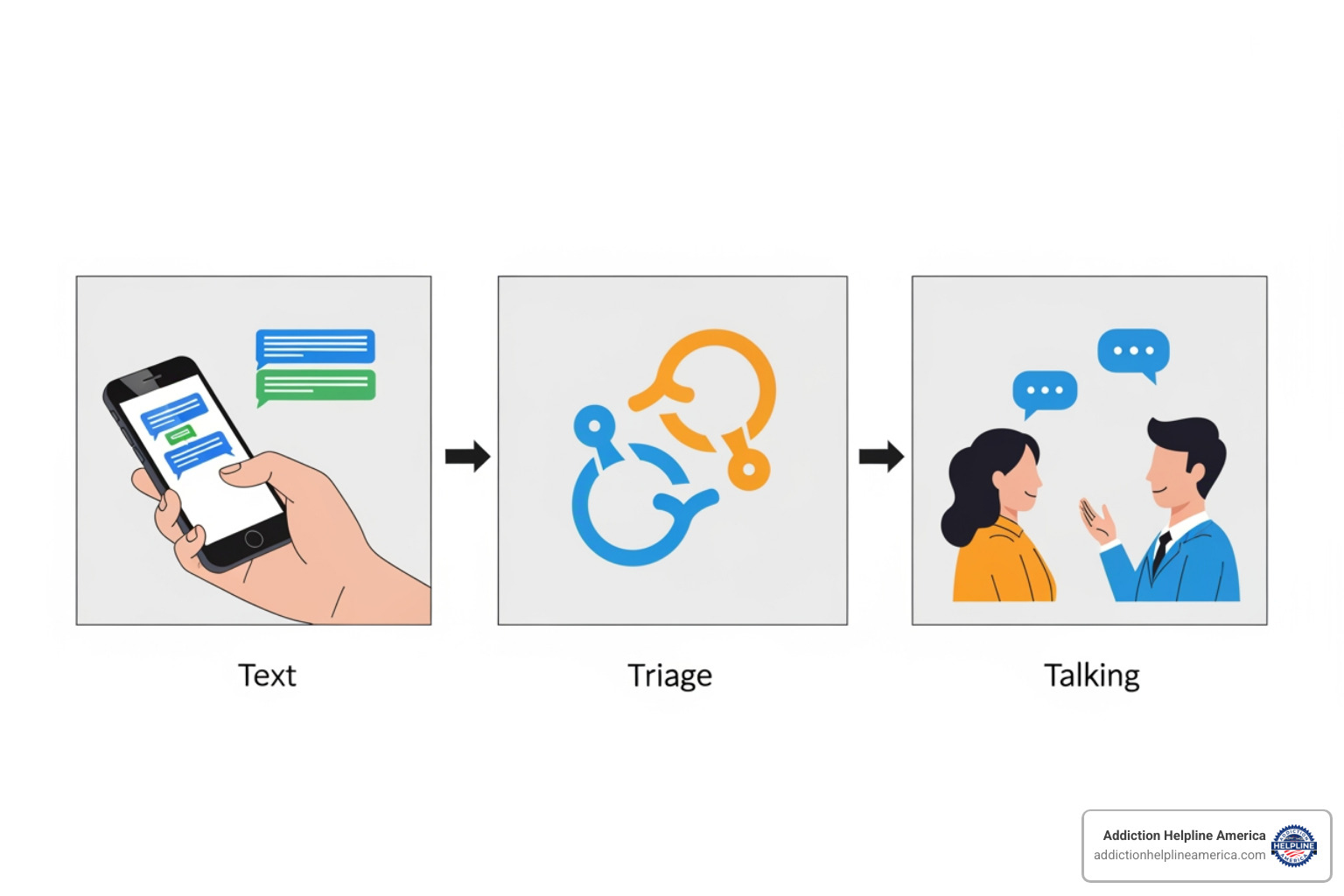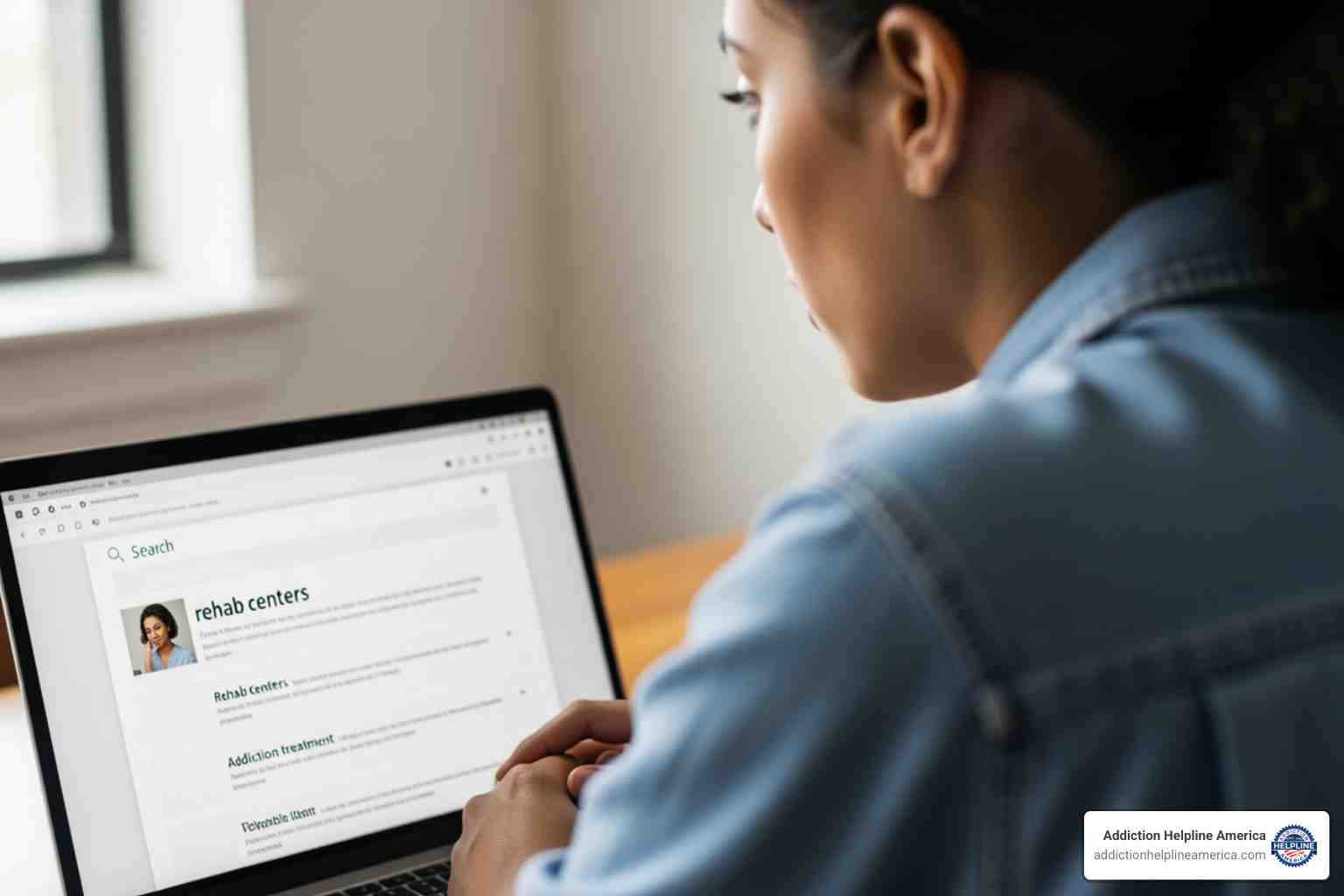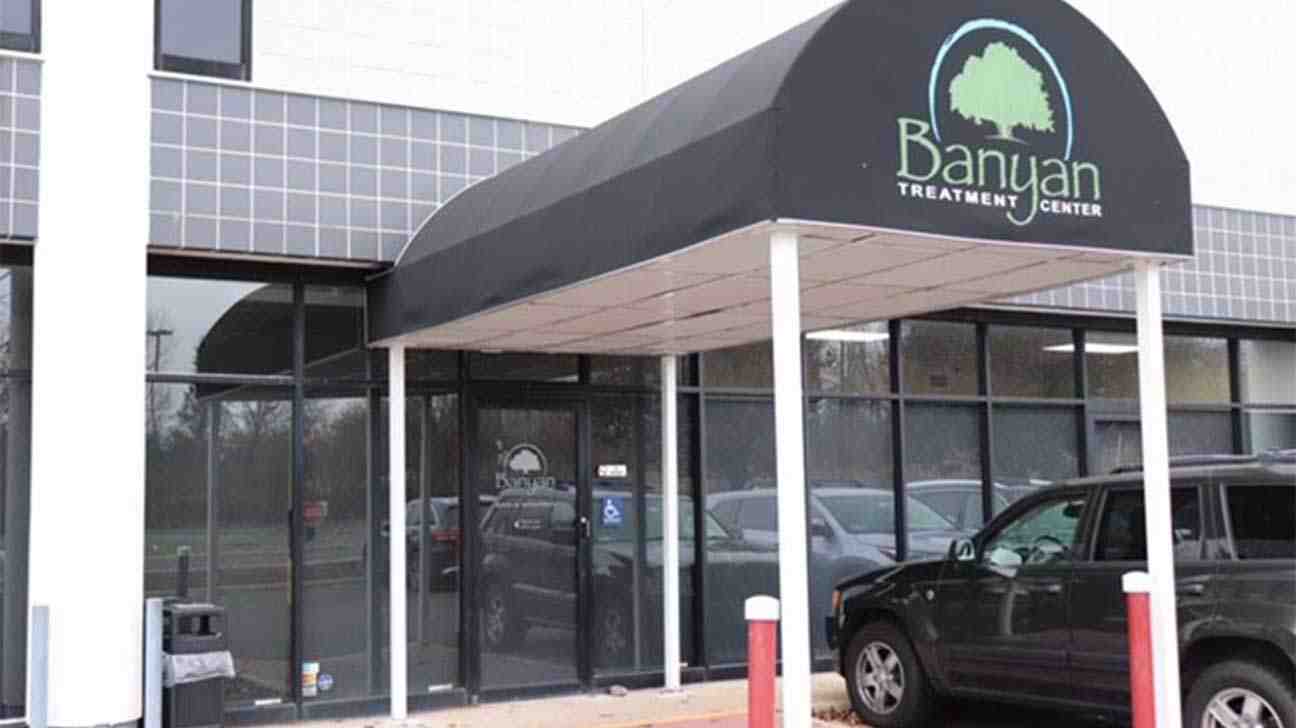
You Deserve to Be Heard
Crisis Text Line is a free, 24/7 mental health support service that connects you with trained volunteer counselors via text message. If you or someone you care about is struggling with anxiety, depression, suicidal thoughts, substance abuse, or any other crisis, here’s what you need to know right now:
Quick Access Guide:
| Location | How to Connect | Number/Method |
|---|---|---|
| United States | Text HOME | 741741 |
| Canada (Youth) | Text CONNECT | 686868 |
| Canada (Adults) | Text WELLNESS | 741741 |
| Anywhere | Online Chat | crisistextline.org |
| Anywhere | Message “HOME” |
Key Benefits:
- Free and confidential – No cost, available 24/7
- Text-based – More comfortable than calling for many people
- Trained counselors – Volunteers receive 30 hours of training
- Proven effective – 85% of texters find the service helpful
- Immediate connection – Real person responds, not a chatbot
The service has supported over 9 million conversations since 2013, with trained volunteers responding to more than 350 million messages. The vast majority of texters report a positive change in mood after using the service.
Crisis Text Line was founded by Nancy Lublin in 2013 after young people started reaching out via text to DoSomething.org about personal crises. What began as an unexpected findy became a lifeline for millions who prefer texting to calling, especially during their darkest moments.
At Addiction Helpline America, we’ve spent years connecting individuals and families to crisis intervention services like Crisis Text Line, and we understand how overwhelming it can be to ask for help with mental health challenges or substance abuse. Our mission is to guide you to the right resources when every moment counts.

Basic crisis text line vocab:
What is a Crisis Text Line and Who Can It Help?
When you’re going through a tough time and don’t know where to turn, the Crisis Text Line offers a quiet place to land. Think of it as having someone in your corner, ready to listen whenever you need them—day or night.
Crisis Text Line is a global nonprofit organization that provides free, confidential mental health support and crisis intervention through text messaging. It’s available 24/7, meeting you exactly where you are. Whether you’re curled up in bed at 2 AM or sitting in a school bathroom trying to hold it together, help is just a text away. No appointments needed. No waiting rooms. Just real support when you need it most.
Call Now – Your Journey to Recovery Begins Today!

Take the first step towards a healthier life! Call now to connect with our compassionate team and start your recovery journey today. Your path to healing awaits!
Our recovery specialists are available 24/7 to provide support, and all calls are confidential and free. Reach out anytime – we’re here to help!
Here’s what makes it special: this service is truly for everyone. It doesn’t matter if you’re 13 or 73, whether you’re facing a major crisis or just having a really bad day. While teens and young adults have especially acceptd texting as their preferred way to reach out, adults find it incredibly helpful too. The volunteers at Crisis Text Line operate on a simple but powerful principle—no issue is too small. That overwhelming anxiety before a test? They’re here for it. Thoughts of self-harm? They’re here for that too. Relationship troubles that have you feeling lost? Yes, they’re here for that as well.
There’s something deeply healing about being heard, really heard, without judgment. That’s the healing power of connection at work—a trained volunteer offering genuine human support in our increasingly digital world.

What Kinds of Issues Does the Service Address?
Life rarely hands us one problem at a time. More often, it’s a tangled web of worries, fears, and challenges that feed off each other. At Addiction Helpline America, we see this every day—someone calling about substance use who’s also battling depression, or a person struggling with anxiety who’s turned to self-harm as a way to cope.
The counselors at Crisis Text Line get this. They’re trained to support you through the messy, complicated reality of whatever you’re facing.
People reach out for help with anxiety—from everyday worries that won’t quiet down to full-blown panic attacks that make you feel like you’re drowning. They text about depression, those heavy days when getting out of bed feels impossible and nothing seems to matter anymore. Loneliness drives many to reach out, that aching sense of being disconnected even when you’re surrounded by people.
Grief takes many forms. Maybe you’ve lost someone you love, or a relationship has ended, or life has changed in ways you never expected. Suicidal thoughts are perhaps the hardest to talk about—when the pain feels so overwhelming that ending your life seems like the only way out. Self-harm offers a different kind of release for some, a way to cope with emotional pain through physical pain.
Then there are the struggles that come from outside: bullying at school or work, relationship problems with friends, family, or partners that leave you feeling stuck. Financial stress keeps people up at night, worrying about bills, debt, or putting food on the table.
Substance abuse is another common reason people reach out. Having a confidential space to talk about drinking or drug use—without fear of judgment—can be the first step toward change. If you’re looking for more guidance on this, our Substance Abuse Treatment Scottsdale Tips offers practical insights for moving forward.
The service also supports people dealing with eating disorders, concerns about body image and unhealthy relationships with food. And for those experiencing any form of abuse—physical, emotional, or sexual—the Crisis Text Line provides a safe space to talk about what’s happening.
Many people don’t realize how often mental health struggles and addiction go hand in hand. Understanding this connection can be a turning point in your healing journey. If you’re curious about treatment options that address both, our guide on Drug for Anxiety and Depression might help.
The Impact of the Crisis Text Line: By the Numbers
Numbers don’t usually tell the whole story, but sometimes they reveal something important. The statistics behind Crisis Text Line show just how many people have found help when they needed it most.
Since the service launched, it has supported over 9 million conversations in the United States alone. That’s 9 million moments when someone reached out in pain and found a person ready to listen. Trained volunteers have responded to more than 350 million messages—each one representing someone’s struggle, hope, or cry for help.
Back in 2015, when the service was still relatively new, more than 350 people were already texting in crisis every single day. The demand has only grown since then.
But here’s what really matters: 85% of texters find the service helpful. Most people report feeling better after their conversation—a genuine shift in mood, even if their circumstances haven’t changed. That’s the power of being heard.
The COVID-19 pandemic tested every support system we have. During those early, frightening weeks, texts to the hotline jumped 47% to 116% higher than a typical day. When the world felt like it was falling apart, people knew where to turn.
In March 2019, Crisis Text Line celebrated a remarkable milestone: 100 Million Messages exchanged between counselors and people in crisis. It’s a number that keeps growing, because the need for compassionate, accessible support never stops.
These aren’t just statistics. They’re real people—maybe someone like you—who found a lifeline when they needed it most. That’s why we at Addiction Helpline America believe so strongly in the power of services like this.
Call Now – Your Journey to Recovery Begins Today!

Take the first step towards a healthier life! Call now to connect with our compassionate team and start your recovery journey today. Your path to healing awaits!
Our recovery specialists are available 24/7 to provide support, and all calls are confidential and free. Reach out anytime – we’re here to help!
Your 3-Step Guide to Getting Help Now
When you’re in crisis, the last thing you need is a complicated process. That’s why Crisis Text Line keeps things beautifully simple. The entire journey from reaching out to talking with a real person follows three straightforward steps that take you from that overwhelming “hot moment” to a place of calm.
Think of it as your roadmap to support: Text, Triage, Talk. Each step is designed to get you connected quickly while ensuring you receive the right level of care. And here’s what matters most—this process empowers you. It gives you back a sense of control when everything feels chaotic, and it equips you with coping skills you can use long after the conversation ends.
Let’s walk through exactly how it works.

Step 1: Reach Out via Text, Chat, or WhatsApp
The hardest step is often the first one—actually asking for help. We know this from years of working with people at Addiction Helpline America. That’s why Crisis Text Line has made reaching out as easy as possible, giving you several ways to connect based on what feels right for you in that moment.
If you’re in the United States, the main way to get help is to text HOME to 741741. That’s it. No complicated phone trees, no waiting on hold, no having to speak out loud when you can’t find the words. Just send that one word, and you’re on your way to connecting with a trained volunteer Crisis Counselor. The service is completely free, confidential, and available every hour of every day.
For those in Canada, youth can text CONNECT to 686868, while adults can text WELLNESS to 741741. Both options connect you with the same quality support, just custom for your location.
Maybe texting from your phone doesn’t feel right, or perhaps you’re somewhere without cell service but have Wi-Fi. No problem. You can start a conversation through their website by visiting their Chat With Us page. The experience is exactly the same—just through a different screen.
If WhatsApp is your go-to messaging app, you can reach Crisis Text Line there too. Simply Message On WhatsApp by sending “HOME” to their number. For many people, using a familiar app makes reaching out feel a little less scary.
And if English isn’t your first language, there’s support for you too. In 2021, Crisis Text Line launched a Spanish language service, ensuring that more people can get help in the language they’re most comfortable with.
The bottom line? Choose whatever method feels most accessible and safe for you. There’s no wrong way to ask for help.
Step 2: Steer the Automated Welcome and Triage
After you send that first message, you’ll get a few automated responses right away. Before you worry that you’re talking to a robot, understand that these initial messages serve an important purpose—and a real person will be with you very soon.
These automated messages will share key information about how the service works, including details about confidentiality and their privacy policy. You might also be asked a couple of questions to help understand what you’re going through. This isn’t busywork. It’s actually part of a sophisticated triage system that helps ensure people who need help most urgently get connected first.
Behind the scenes, Crisis Text Line uses an algorithm to analyze the language in incoming messages. This technology, which Nancy Lublin discusses in her powerful TED talk on texting that saves lives, can identify words and phrases that indicate higher levels of risk. When someone is in imminent danger, the system prioritizes their conversation so they can connect with a counselor faster.
This isn’t about making anyone wait—it’s about using technology to save lives. And while this brief automated process is happening, a trained volunteer is already being assigned to your conversation. You’re not being ignored. You’re being carefully connected to the right support.
Step 3: Connect with a Trained Crisis Counselor
This is where everything comes together. After those initial automated messages, you’ll be connected with a live, trained volunteer Crisis Counselor—a real human being who is there specifically for you.
These volunteers aren’t just kind-hearted people with good intentions. Each one has completed a rigorous 30-hour training program that teaches them the skills they need to provide genuine, effective support. They’re trained in active listening, which means they’re truly hearing what you’re saying, not just waiting for their turn to talk. They’re trained in validation—acknowledging that your feelings are real and understandable. And they’re trained in empathy, creating a space where you feel genuinely cared for.
The conversation itself is collaborative. Your counselor won’t lecture you or tell you what to do. Instead, they’ll work with you to explore what you’re feeling, identify your strengths (yes, you have them, even now), and help you develop coping skills that work for your specific situation. If there’s an immediate safety concern, they’ll help you build a safety plan, always keeping your well-being at the center of everything.
The goal isn’t just to get you through this one crisis. It’s to help you move from that overwhelming “hot moment” to a place of calm, and to empower you with tools you can use the next time things get hard. If you need additional support beyond this conversation, your counselor can also provide resource referrals to other organizations that might help.
For people struggling with substance abuse, this connection can be a crucial First Step to Recovery. Sometimes just having someone listen without judgment opens the door to seeking more specialized treatment. That’s where services like Addiction Helpline America can step in, helping you find the right recovery program for your unique needs.
The beauty of Crisis Text Line is that it meets you exactly where you are, offers genuine human connection when you need it most, and helps you find your path forward—one text at a time.
Behind the Curtain: How the Crisis Text Line Operates
If you’ve ever wondered what makes Crisis Text Line tick, you’re about to find a beautiful blend of human heart and smart technology working together to save lives.
The story starts with Nancy Lublin, the visionary founder who launched Crisis Text Line in 2013. At the time, she was running DoSomething.org, a nonprofit that gets young people fired up about social change. But something unexpected started happening—young people began texting DoSomething not about volunteer campaigns, but about deeply personal struggles. They were sharing stories of abuse, depression, and thoughts of self-harm. Nancy realized she’d stumbled onto something profound: young people needed help, and they wanted to ask for it through text.
That insight became the foundation of Crisis Text Line. What began as a response to a few texts has grown into a lifeline that’s supported over 9 million conversations. The service has expanded far beyond U.S. borders, too. In 2018, Crisis Text Line partnered with Kids Help Phone to bring the service to Canada. By May 2019, they’d launched Shout, their United Kingdom affiliate, and extended support to Ireland as well. This global expansion doesn’t happen by accident—it’s been fueled by significant backing from major philanthropists, including a $23.8 million investment from Reid Hoffman, Melinda Gates, Ballmer Group, and Omidyar Network, which has helped the organization scale its impact while maintaining its commitment to quality care.

The Volunteers: The Heart of the Helpline
Behind every conversation on Crisis Text Line is a real person who’s chosen to spend their time helping strangers through their darkest moments. These volunteers—called Crisis Counselors—are truly the heart of the operation. They’re not paid staff; they’re everyday people who’ve made an extraordinary commitment to be there for others.
Becoming a Crisis Counselor isn’t something you can do on a whim. The training is rigorous and thorough: a 30-hour program that’s virtual, interactive, and self-paced. Volunteers learn the art of active listening, crisis intervention techniques, and how to collaborate with texters to solve problems together. Once they complete the training, they commit to at least 200 hours of service—that’s a serious dedication to helping others.
Here’s something that sets this program apart: every single conversation is monitored by clinical supervisors who provide real-time support and feedback. If a volunteer isn’t sure how to respond or encounters a particularly challenging situation, they’ve got an experienced professional right there to guide them. This safety net ensures that texters always receive high-quality, compassionate care, even from volunteers who might be handling their first crisis conversation.
The volunteer opportunities are open to U.S. residents aged 18 and older who can pass a background check. It’s a chance to make a real difference from your own home, on your own schedule. The work is so meaningful that even Prince William revealed he volunteers for a crisis helpline, showing that the call to help others transcends all backgrounds.
What to expect from a crisis text line conversation
When you text Crisis Text Line, you’re entering a conversation designed to meet you exactly where you are. There’s no judgment, no pressure to share more than you’re comfortable with, and no predetermined script. The Crisis Counselor on the other end will listen to your story, validate what you’re feeling, and work alongside you to find immediate ways to cope with what you’re going through.
These volunteers are trained to help you move from that overwhelming “hot moment” to a calmer, more manageable state. They’ll collaborate with you to identify your strengths, explore your options, and if needed, build a safety plan. If you’re dealing with challenges related to substances, this can be an important first step toward recovery, especially when issues like adolescent substance abuse are involved.
What makes Crisis Text Line particularly innovative is its data-driven approach. The organization carefully analyzes anonymized conversation data to spot mental health trends across the country. This information, available through resources like Crisistrends.org, helps them understand what people are struggling with most, when crises tend to spike, and how to improve their service. As the New York Times described it, it’s “A Crisis Line That Calms With Texting and Data”—using both human empathy and smart technology to save lives.
This commitment to learning from data—while protecting your privacy—allows them to continuously refine how they help. Nancy Lublin’s TED talk on texting that saves lives beautifully explains how this marriage of technology and compassion has transformed crisis intervention for the digital age.
Privacy, Ethics, and Comparisons to 988 & 911
When you’re at your most vulnerable, the last thing you should worry about is whether your conversation is truly private. We know that trust is everything when it comes to mental health support, and Crisis Text Line takes your confidentiality seriously. Every conversation you have with a Crisis Counselor is kept private—it’s just between you and them. The service is designed to be as anonymous as possible, creating a safe space where you can open up without fear of judgment or your personal information being shared.
That said, there’s an important exception you should know about, and it exists for your safety. Crisis Text Line has what’s called an “active rescue” policy. In rare situations where a texter is at imminent risk of harming themselves or others, and a safety plan cannot be established through conversation, the organization may contact emergency services. This isn’t done lightly. The priority is always to work with you to create a plan that keeps you safe. Active rescue is truly a last resort, used only when there’s an immediate, life-threatening danger. Whenever possible, counselors will inform you of this step and work collaboratively with you, respecting your informed consent while prioritizing your safety above all else.
Understanding how to steer the broader mental health system, including insurance coverage, can also help you plan for long-term support beyond crisis moments. Our Behavioral Health Insurance Plans Guide can be a helpful resource for that journey.
Understanding Data Privacy and Ethical Considerations
Here’s where things get a bit more complicated, and we believe in being transparent with you about it. Crisis Text Line has been a pioneer in using anonymized data from conversations to identify mental health trends across the country—what they call “data for good.” This information helps them understand what people are struggling with most, when crises tend to spike, and how to improve their service. In theory, it’s a powerful tool for public health.
However, in early 2022, the organization found itself at the center of a significant privacy controversy. A Politico investigation revealed that Crisis Text Line had been sharing anonymized conversation data with a for-profit spinoff company called Loris.ai. This company was using the data to develop customer service software—essentially commercializing sensitive mental health information, even though it was stripped of identifying details.
The backlash was swift and understandable. People who had trusted Crisis Text Line with their deepest struggles felt betrayed, and the ethical questions were serious: Should data from mental health crises ever be used for commercial purposes, even if anonymized? Is there truly informed consent when people reach out in their darkest moments?
To their credit, Crisis Text Line listened. Within days, the organization announced it would end all data sharing with Loris.ai, the for-profit spinoff. They acknowledged the concerns and made policy changes to rebuild trust. Today, the organization maintains its commitment to using anonymized data only to improve crisis intervention services and understand broad mental health trends. They’ve strengthened their anonymization protocols and transparency about data practices.
It’s a reminder that even well-intentioned organizations can stumble, and that ongoing vigilance about privacy is essential in the digital age. The important thing is that Crisis Text Line course-corrected and remains committed to protecting the privacy of those who reach out for help.
Crisis Text Line vs. 988 and 911: Which Service to Use
One of the most common questions we hear at Addiction Helpline America is: “Which number should I actually call or text?” When you’re in crisis, the last thing you need is confusion about where to turn. Let’s break down the differences between Crisis Text Line, 988, and 911 so you can make the best choice for your situation.
Crisis Text Line (Text HOME to 741741) is your go-to when you’re struggling emotionally but not in immediate physical danger. Maybe you’re feeling overwhelmed by anxiety, battling loneliness at 2 AM, dealing with depression, or wrestling with thoughts of self-harm. Perhaps you’re struggling with substance use and need someone to talk to confidentially. The beauty of texting 741741 is its discretion—you can reach out from anywhere without anyone around you knowing. Trained volunteer Crisis Counselors will help you work through your feelings, develop coping strategies, create a safety plan, and connect you with resources. It’s text-based support focused on de-escalation and empowerment.
988 Suicide & Crisis Lifeline (Call or Text 988) serves a similar purpose but is specifically designed for suicide prevention and mental health crises. If you’re actively experiencing suicidal thoughts, in a severe mental health crisis, or facing overwhelming emotional distress that feels unmanageable, 988 connects you directly with trained crisis counselors at local crisis centers. They can provide immediate support, help you develop a safety plan, and connect you to local mental health services. You can either call or text, depending on your preference.
911 (Call) is reserved for immediate, life-threatening emergencies. This is when someone’s physical safety is at risk right now. A suicide attempt in progress, active violence, a severe medical emergency, a fire, or any situation requiring immediate intervention by police, firefighters, or paramedics—that’s when you call 911. First responders will arrive on scene to provide physical intervention, medical treatment, or law enforcement assistance. While 911 should always be used for life-threatening situations, it’s worth noting that for psychiatric emergencies that might require a visit to a Mental Hospital Near By Me, calling 911 can connect you with crisis intervention teams trained in mental health response.
Here’s a simple way to think about it: Text 741741 when you need emotional support and someone to talk things through. Call or text 988 when you’re in a mental health crisis and need immediate crisis counseling. Call 911 when there’s an immediate threat to physical safety that requires emergency responders.
All three services are valuable, and choosing the right one simply depends on what you’re facing in that moment. There’s no wrong choice if it gets you help—and reaching out in any form is always the right move.
Call Now – Your Journey to Recovery Begins Today!

Take the first step towards a healthier life! Call now to connect with our compassionate team and start your recovery journey today. Your path to healing awaits!
Our recovery specialists are available 24/7 to provide support, and all calls are confidential and free. Reach out anytime – we’re here to help!
Frequently Asked Questions
You’ve learned a lot about Crisis Text Line, but we understand you might still have some lingering questions. At Addiction Helpline America, we’ve heard these questions time and again from people just like you who are considering reaching out for help. Let’s clear up any remaining uncertainties.
Is the service truly free and confidential?
The short answer is: yes, completely. The Crisis Text Line is genuinely free, 24/7, and confidential for anyone in the United States. There are no hidden fees, no surprise charges on your phone bill, and no barriers to getting help when you need it most.
Here’s why you can trust this promise: Major U.S. carriers—including Verizon, Sprint, T-Mobile, and AT&T—have all agreed to waive fees for messages to and from the service. This commitment was established early on, as highlighted in “Carriers Waive Charges for Crisis Text Line”. For most people, these texts won’t even appear on your phone bill, offering an extra layer of discretion.
As for confidentiality, your conversations are kept private between you and your Crisis Counselor. This creates a safe, judgment-free space where you can share your deepest concerns without worrying about who might find out. It’s this combination of being truly free and genuinely confidential that makes the service so accessible to everyone, regardless of their circumstances.
How can I become a volunteer Crisis Counselor?
If you’re reading this and thinking, “I want to be part of this,” you’re already showing the kind of compassion that makes a great Crisis Counselor. Becoming a volunteer for Crisis Text Line is a deeply rewarding way to make a real difference in people’s lives, right from your own home.
Here’s what the journey looks like: You’ll start by completing an online application to express your interest. If accepted, you’ll participate in a free, 30-hour training program that’s virtual, interactive, and designed to fit your schedule. This isn’t just basic training—it’s comprehensive preparation that equips you with genuine crisis intervention skills, teaching you active listening, empathy, and how to help someone move from crisis to calm.
Once you’re trained and certified, you’ll commit to 200 hours of service, typically spread over a year. This ensures you have enough practice to become confident and effective. You’ll need to pass a background check to protect the safety of texters. And to be eligible, you must be 18 years of age or older and a U.S. resident.
It’s an incredible opportunity to give back, to be there for someone during their darkest moment, and to know that your words truly matter. Every volunteer plays a vital role in this life-saving network.
What happens if I am in immediate, life-threatening danger?
This is an important question, and we want to be completely transparent about how Crisis Text Line handles situations involving serious, immediate danger. Your safety is always the absolute top priority, and the service has protocols in place to protect you.
When you reach out, the Crisis Counselor will assess for imminent risk—whether you’re in danger of harming yourself or someone else is threatening your safety. Their first instinct, always, is to work collaboratively with you. Safety planning is the priority, and they’ll do everything possible to help you create a plan that keeps you safe, empowering you to take steps that protect your well-being.
However, in very rare circumstances where someone is determined to be in imminent, life-threatening danger and cannot or will not create a safety plan, the Crisis Counselor may need to initiate what’s called an “active rescue.” This is truly a last resort. It means they might contact emergency services (like 911) using any information you’ve shared, such as your location, to ensure you get immediate help. This decision is never made lightly—it’s done with extreme caution and, whenever possible, with your awareness and in collaboration with you.
The goal is never to take control away from you, but rather to ensure that you stay alive and can continue your journey toward healing. If you’re in immediate danger right now, please don’t hesitate to call 911 directly or reach out to 988 for crisis support. And remember, for ongoing support with substance abuse or mental health challenges, services like Addiction Helpline America can guide you toward the right treatment resources.
Conclusion: Your Path to Support Starts with a Single Text
Sometimes, in the middle of a really hard day—or night—it can feel like you’re completely alone. But here’s something we want you to remember: you’re not. Help is genuinely just a text away, and that’s not just a comforting phrase. It’s the reality that Crisis Text Line has created for millions of people across the country.
Throughout this guide, we’ve walked through how this service works—from that first brave text to 741741, through the brief automated triage, to connecting with a real person who cares. We’ve seen the numbers: over 9 million conversations, more than 350 million messages, and an 85% satisfaction rate. But behind every statistic is a person who was struggling and found someone to listen, someone to help them move from crisis to calm.
Reaching out is strength, not weakness. It takes courage to admit you’re hurting, to ask for help when everything feels overwhelming. Whether you’re dealing with anxiety that won’t quit, depression that’s pulling you under, thoughts of self-harm, or struggles with substance abuse, the trained volunteers at Crisis Text Line are there. They won’t judge you. They won’t tell you your problems are too small or too big. They’ll just listen, and together, you’ll work toward finding your footing again.
We’ve covered a lot in this article—the three simple steps to get help, how the service operates behind the scenes, the privacy protections in place, and how it compares to other crisis services like 988 and 911. The key takeaway? You have options, and you deserve support.
At Addiction Helpline America, we’ve spent years connecting people to the right resources at the right time. We know that crisis support like Crisis Text Line is often the first step, but sometimes you need more. If you or someone you love is battling ongoing mental health challenges or substance abuse, specialized treatment might be the next chapter in your recovery story. Our network spans states from Alabama to Wyoming, and we’re here to provide free, confidential guidance to help you find the right program for your unique situation.
Ready to take the next step beyond immediate crisis support? Find help through Addiction and Rehab Hotlines and find the resources available to you. Whether it’s your first time reaching out or you’ve tried before and need to try again, we’re here. Hope isn’t just a word—it’s a text message, a phone call, a conversation that changes everything. Don’t wait. Your path to healing starts now.
Our helpline is 100%
free & confidential
If you or someone you care about is struggling with drug or alcohol addiction, we can help you explore your recovery options. Don’t face this challenge alone—seek support from us.
Programs
Resources
Will my insurance
cover addiction
treatment?
We're ready to help
Find the best
drug or alcohol treatment
center
Are you or a loved one struggling with addiction? Call today to speak to a treatment expert.















